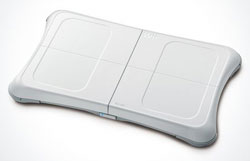Games /
Game Reviews
Wii Fit Brings Gamers to Their Feet
By Philip Schweier
May 25, 2008 - 08:12
Critics have said that over the past 30 years, home video games systems have bred a nation of unhealthy couch potatoes. Wii Fit just may be the start of a new trend.
When the Nintendo Wii debuted in 2006, it was regarded as a step up from the traditional video game system. Instead of a simple hand control, the Wii featured a motion-sensitive wand that allowed for a greater degree of interaction. This wand serves as a physical relay, allowing for realistic movement when playing Wii game versions of tennis, golf or baseball, boxing or bowling, which are included with the basic game system.
With the wand came a second hand-held device called a nunchuck, as it was joined to the wand by a cord. With the wand in one hand and the nunchuck in the other, a player could engage in any number of games involving both hands, such as boxing. A player's hand movements were mirrored by his or her character (called a Mii) on the screeen.
It quickly became obvious that pulling players off the couch and getting their entire body into the game – rather than fingers and thumbs – proved to be a rather effective workout. Critics hailed the Wii system for it's greater degree of interactive play.
Now Nintendo has released the Wii Fit, which capitalizes in the interactive qualities of the game system by featuring more than 40 activities, including interactive trainers, to help players stay more fit.
It comes as a balance board, which resembles a smaller version of the individual platform often found in step aerobics. By standing on the platform, a player is assessed in a variety of physical attributes such as weight and posture. All this data is entered into the Wii system to determine a player's body mass index, to create an overall health profile based on height and weight.
While this may be humbling process, it might be argued that a little embarrassment can be a motivating factor to put down the joy stick and step up to the balance board. And for those who wish to keep his or her weigh-in private, there is a password-protected lock-out feature.
The player can then choose a number of exercise programs: yoga, and strength training, both of which offer male or female interactive trainers; and balance and aerobics, which are a series of games designed to improve basic general health.
For instance, balance can be a determining factor when it comes to back aches, leg cramps and other physical ailments. The Wii Fit uses a variety of challenges, such as a tight-rope scenario, to help achieve better balance. Players can compete against each other to achieve the better time, while trying to avoid traditional video game obstacles.
It is possible to cheat, however, as not all the activities require bonafide physical participation to register on the system. Moving the hand-held device from a sitting position is one way to foil the system into thinking you're jogging.
The Wii Fit offers a reward system, enabling players to access more advanced games and activities as they progress successfully through the menu.
One of the assets of the Wii Fit is that even after a simple 20-minute exercise session, players can be re-assessed and changes noted. Simple stretching exercises from the yoga program, a quick jog around the virtual park and a few trips down the ski slope can result in visible improvements according to recorded data.
The system retails for $89.99, and while the investment may or may not result in a slimmer, trimmer gamer, it may get people off the couch and into increasingly physical activities. It may also open the door to additional interactive game systems that exercise more than the stereotypical doughy gamer's ability to shoot down alien spacecraft.
Last Updated: January 17, 2025 - 08:20


